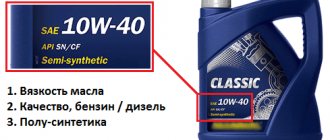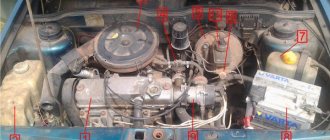About engines for VAZ 2121 Niva
The most popular domestic SUV, the VAZ 2121 Niva, was developed on the basis of the VAZ six.
The engine also remained from the VAZ 2106, but received cosmetic improvements. Later, the 213 1.7-liter engine and the 2130 1.8-liter engine were created. Along with the regular Niva, the Chevrolet Niva is also produced, which is equipped with a slightly modified 213 engine. VAZ 2106 engine
The basic unit for the Niva is an evolution of the engine from the Troika, and it is distinguished from the 2103 engine by a piston increased to 79 mm, with the same cylinder block.
Also relevant is the injection unit 21067, which is covered by the cylinder head from the injection unit 21214. During operation, it turned out that it is the carburetor version that is distinguished by stability.
The in-line engine 2106, both carburetor and injection, received 4 cylinders with a camshaft located at the top and a timing chain drive.
The engine should be classified as a classic high-block unit.
With careful operation and regular maintenance, the engine will exceed its factory service life of 125 thousand km and sometimes reach 200 thousand. At the same time, you can hardly call it more reliable than the 2103.
Before setting off, the 2106 engine needs to be warmed up, and in winter this procedure takes about 5 minutes. You can start moving when the engine starts idling.
You should not skimp on high-quality motor oil, since with low-quality consumables, after 60 thousand mileage, the cylinder diameter will expand by 0.15 mm.
If increased oil consumption is noted, the compression should be measured.
The “disease” of the VAZ 2106 is called premature wear of the camshaft.
The absence of a hydraulic compensator forces valve clearances to be adjusted every 7-10 thousand kilometers.
Also, driving a car with a six-engine engine is filled with noise, knocking and other extraneous sounds. For example, the engine knocks when running on low-octane gasoline, but the problem disappears with normal fuel.
Metallic knocks are produced by piston pins and connecting rod bearings.
From the bottom of the engines, simultaneously with a drop in the oil level, sounds are heard when there are problems with the main bearings. In this case, it is better to turn off the car and tow it to a service station.
Unstable operation of the VAZ-2106 engine is caused by clogged jets.
If it stalls at idle, you need to adjust the speed or the air damper. If it stalls while driving, the reason lies in the power supply or ignition.
Excessive temperature or engine boiling is associated with air in the cooling system.
Engine trouble is caused by misadjusted or burnt-out valves, a failed cylinder head gasket, or low-octane fuel.
Engine vibrations usually occur when the cushions wear out, as well as when the crankshaft or cardan is unbalanced.
Engine VAZ 2130 Niva 1.8
The 2130 power unit for the VAZ Niva received four cylinders with an overhead camshaft and a timing chain drive.
The engine should be classified as a traditional representative of the high-block motor series.
If we compare the 213th and 2130, the second is 1.3 mm higher, which made it possible to install a crankshaft with an 84 mm piston stroke on the engine and increase the engine capacity to 1.8 liters.
To the above disadvantages, inherent to both the VAZ 2106 and 2130, one can add increased wear of the camshaft and the need for regular adjustment of valve clearances, which will be signaled by a knocking sound when the engine is running at idle.
Engine VAZ 21213 / 21214 Niva
Based on the VAZ 21214 engine, the engine for the Niva Chevrolet was also assembled, and the differences consist only in the adaptation of the BC for installation in the Chevy engine compartment and fastening of attached parts and assemblies.
Description of design
Driver's workplace.
VAZ-2121 (21213/21214) is a small-class all-terrain vehicle (SUV). The body is monocoque, three-door - hatchback type, five-door - station wagon. Transmission with permanent all-wheel drive, four-speed manual gearbox (starting from 21213 - five-speed), two-speed transfer case and locking center differential. The geometric parameters of cross-country ability are good due to the fairly high ground clearance (220 mm), small body overhangs (approach angle 32°, departure angle 37°) and a relatively short 2.2-meter wheelbase. The first VAZ-2121 model was equipped with a VAZ-2121 engine, created on the basis of the VAZ-2106 engine, an in-line four-cylinder carburetor with a volume of 1580 cm³. Power 80 l. With. at 5400 rpm, maximum torque 116 Nm at 3400 rpm. The restyled modification of the VAZ-21213 was equipped with a VAZ-21213 carburetor engine with a displacement increased to 1690 cm³ and a power of 81.9 liters. With. at 5100 rpm and maximum torque of 126.1 Nm at 3000 rpm.
One of the features of the Niva is the use in its design of large-scale units from the VAZ model range. Thus, from the VAZ-2106 model, a 1.6-liter engine with a timing chain drive, a gearbox and a rear axle gearbox were used (on the first Nivas, the axle gearboxes used main gears from the VAZ-2101 with a gear ratio of 4.3). Nevertheless, the Niva immediately demonstrated cross-country ability that was unique for its class.
In October 2020, on the LADA 4×4, VAZ introduced a bearing into the front hubs that does not require periodic adjustment. The car has a modernized steering knuckle, independent mounting of the front axle gearbox and gas-filled shock absorbers[12][13].
AVTOVAZ's BRONTO division, based on the Niva platform, produces special commercial SUVs and armored vehicles for civilian use.[14]
Piston stroke VAZ 21213
The VAZ 21213 engine can be used for installation on VAZ Niva cars: 2121, 21213, 21214, 2131; "Nadezhda" 2120 and their modifications.
This internal combustion engine was developed specifically for the Niva VAZ-21213 car. Based on the center-to-center distance of the cylinders of 95 mm, it can be classified as a group of internal combustion engines installed on rear-wheel drive cars. They were located in the engine compartment along the axis of the car.
Engine cylinder block 21213-1002011 with a center-to-center distance of 95 mm and a height of 214.58-0.1 mm (distance from the axis of rotation of the crankshaft to the upper surface of the block). The nominal diameter of the cylinders is 82mm. TBO dimensions - 82.40 and 82.80. Five classes are defined based on the deviation of the cylinder diameter. The size of each class differs from the previous one by 0.01mm. Classes are designated by letters (A, B, C, D). The cylinder block is marked on the lower surface of the block (see “Cylinder block”).
The engine is equipped with a crankshaft 21213-1005015. According to its parameters, it corresponds to the crankshaft 2103 and provides a piston stroke of 80 mm. (crank radius – 40mm.). The shaft has additional counterweights that reduce vibration. There are two oil supply holes on each crankpin. The diameters of the shaft journals are increased by 0.02 mm. When using standard bearings, this reduction in clearances optimizes the thickness of the oil layer between the shaft journal and the bearing surface. At the same time, reducing clearances improves the dynamic characteristics of the shaft. Crankshaft 21213 is recommended for installation instead of shaft 2103.
A new piston group has been developed for the engine. Piston 21213 is of original design; it has a specific oval hole on the bottom. For piston diameters, classes corresponding to cylinder classes are defined. The hole for the piston pin is 22mm in diameter. In the piston, the hole for the piston pin is offset by 1.2 mm from the piston axis. The piston class marking by diameter and pin hole size is indicated on the piston bottom. The piston pin, 67 mm long, is fixed in the piston with retaining rings. The weight of the piston is 347g. During manufacturing, all pistons are brought to the same weight.
Connecting rod 21213-1004045 has a new design. The length of the connecting rod is 136 mm. Hole sizes: for the connecting rod journal - 47.8 mm; piston pin – 22mm. New bolts were used to fasten the connecting rod cover, ensuring reliability and accuracy of assembly.
The cylinder head 21213-1002011 (for a 1.7-liter engine) is structurally similar to the 21011 head, but has a number of differences. The height of the head 21213 is 111.0mm, which is 1.8mm lower than the head 21011. The size of the combustion chamber is 81x52 mm, volume 30 cm3.
A new camshaft 21213-1006010 has been developed for the engine. The shape of the cams has been changed to increase the intake valve stroke. The valves and valve train from the 2101 engine are used.
The camshaft drive is chain. Double-row bush-roller chain mod. 2103. A new extended tensioner shoe is used.
Changes in the power system - the use of a 21073 Solex carburetor.
The VAZ 21213 engine is equipped with a non-contact ignition system. The ignition distribution sensor 3810.3706 is responsible for creating control pulses for the switch. The ignition system uses a switch model - 3620.3734. Ignition coil - 27.3705.
Marking of pistons VAZ 21213
VAZ's pilot production facility has been making 1.8-liter Niva engines for five years—about twenty thousand of them have already been assembled. But, alas, the plant traditionally remains silent about the differences between their original small-scale parts and the basic ones - even a catalog with the simplest drawings has not yet been published.
Therefore, when in doubt, motorists sometimes have to take a roundabout route. For example, placing two parts of the same type next to each other, carefully compare them, measure them, and at the same time photograph them in order to share the experience with your friends. Let us recall the history of the creation of the most “large-caliber” VAZ carburetor engine. Back in 1994, with the start of serial production of the 1700 cc Niva, Tolyatti tuning companies began increasing the displacement of its engine. Of course, there was no talk about boring the cylinders beyond 82 mm - you can’t stuff pistons of “Volgov” size into an initially 1200 cc Fiat engine. And it was possible to play with the piston stroke - for example, by using a crankshaft with an increased crank radius and, accordingly, cutting the piston skirts so that they did not reach the counterweights. Additionally, camshafts with higher cams, milled cylinder heads and other long-known techniques for increasing power at the expense of durability were used. The demand for “charged” piece-assembled units gradually increased, so tuning ideas soon found small-scale implementation in the VAZ engine workshop: in 1996, they began producing the VAZ-2130 engine. Its main difference from the base “two hundred and thirteenth” is an increase in piston stroke by almost 4 mm, which was achieved thanks to a new crankshaft with a larger crank radius and a higher (1.4 mm) cylinder block.
Niva engine characteristics
Years of manufacture – (1994 – present day) Cylinder block material – cast iron Power system – carburetor (21213) / injector (21214) Type – in-line Number of cylinders – 4 Valves per cylinder – 2 Piston stroke – 80mm Cylinder diameter – 82mm Compression ratio – 9 .4 Niva engine capacity 21213 – 1690 cm3. Engine power Niva 21213 – 81 hp. /5200 rpm Torque - 125 Nm / 3000 rpm Fuel - AI93 Fuel consumption - city 11.5l. | track 8.3 l. | mixed 10.5 l/100 km Oil consumption - 700 g per 1000 km Niva engine weight - 117 kg Overall dimensions of the Niva 21213 engine (LxWxH), mm - Oil in the Niva 21213 engine: 5W-30 5W-40 10W-40 15W-40 How much oil in the Niva 21213/21214 engine: 3.75 l. When replacing, fill in about 3.5 liters.
Technical characteristics of engine 21213
VAZ 21213 is a 1.7 liter petrol 4-cylinder 8-valve carburetor engine. The engine was created on the basis of 2121 and taking into account the developments of the VAZ 2107 unit. Engineers partially changed the original design to achieve better ergonomic characteristics of the Niva’s internal combustion engine:
- increasing power from 73 to 78.9 hp. and torque from 116 to 126 Nm;
- reducing fuel consumption to 12 liters per 100 km.
In addition to increasing the cylinder diameter to 82 mm, VAZ developed new pistons and a crankshaft for the 21213 engine. We replaced the outdated Ozone carburetor with the Solers, the most popular and successful model in the early 90s. Improved ignition and cooling systems.
To lubricate the 21213 engine, oil is selected depending on the climate:
- from -25℃ to +35℃ viscosity 10W-40 is recommended;
- from -2℃5 to +45℃ - 15W-30;
- from -30℃ to +20℃ - 5W-30, etc.
The manufacturer indicates the preferred brands of oils: Lukoil, ESSO, Rexol, Yar-Marka, Norsi, Shell, etc.
| Technical characteristics of the VAZ 21213 engine | Meaning |
| Number of cylinders/valves | 4/8 |
| Cylinder diameter/piston stroke, mm | 82/80 |
| Compression ratio | 9,3 |
| Cylinder volume, l | 1,69 |
| Crankshaft power, hp, at 5200 rpm | 78,9 |
| Torque , Nm, at 3000 rpm | 126 |
| Idle speed, rpm | 750 — 800 |
| Oil volume, l | 3,75 |
| Oil consumption , l/1000 km | 0,7 |
| Gasoline consumption, l/100 km, combined | 10,5 |
| Fuel type | AI-93 |
| Fuel tank volume, l | 42 |
| Dry weight , kg | 117 |
| Declared engine resource , thousand km | 80 |
Despite the factory-specified service life of engine 21213 being 80 thousand km, in practice the engine lasts 150 thousand km before overhaul, provided that high-quality fuels and lubricants are used and moderate operation.
Based on the 21213 engine, the 21214 unit with an injector was developed. The technical characteristics of the motors are identical. The designs differ in the power supply system, timing drive and the presence of hydraulic compensators. According to environmental requirements, the injection version meets the Euro-3 standard.
Similar article Technical characteristics of the VAZ 21214 engine
Malfunctions and repairs of the VAZ 21213 / 21214 Niva engine
Engine VAZ 21213 1.7 l. carburetor/injection (21214) in-line 4-cylinder with overhead camshaft, Niva timing belt has a chain drive. Based on the 214 engine, the VAZ 2123 engine is produced for the Chevy Niva; the differences in adapting the block for installing a pulley in the engine compartment and mounting attachments are technically almost identical. The main differences between the VAZ 21213 engine and the 2106 are the cylinder diameter is 82 mm, the cylinder head, the Niva 21213 engine block from the 2106 is smaller in height. Among the advantages of the 213 engine, it is worth noting the presence of a chain tensioner (no need to tighten it) and hydraulic compensators (no need to adjust the valves). Disadvantages of the Niva engine - noisy, consumes oil, prone to overheating and vibrations, low resource. The motor has all the problems of the classic series, the 21213 Niva engine still heats up, troits, knocks, etc., what the problems are, for each case, are described in detail HERE, in the problems and malfunctions section.
Marking of pistons VAZ 21213
2.8.1. Device Features
Main dimensions of the connecting rod and piston group
Piston and connecting rod markings
| Head bolt washer: a – 2101-1003265, outer diameter – 24 mm, inner diameter – 12.2 mm, thickness – 5 mm – for all 1.2–1.7 liter Zhiguli and NIV engines, complete with an old-style elastic bolt with an external hexagon “19”; b - 2108-1003265 size 22x12.2x5 mm for bolts with a 10-point hexagon socket - for 8-valve engines of front-wheel drive VAZs and a 1.8-liter Niva engine (the first option for mounting the cylinder head); c - 2130-1003271 size 22x12.2x0.5 - only for the 1.8 liter Niva engine (the second mounting option with bolts 21213-1003271 with an external hexagon "12"); g - 2112-1003265, size 22x10.2x5, for a thin bolt with a 10mm internal hexagon - only for 16-valve engines of the 2110 family. | Cylinder block: a – 21213-1002011 without marks with a height of 214.58-0.1 mm for all 1.7-liter Lada and Niva engines; b - 2130-1002011 215.98-0.1 mm high, marked with red, white or yellow (in general, any) paint on the breather neck - for 1.8 l engines |
| Block head: 21011-1003011 without marks, with a step about 2 mm high (shown by an arrow) and a combustion chamber measuring 79x51 mm, volume 33.2 cm3 - for all Lada and Niva engines 1.2–1.6 l , except 2105; 21213-1003011, marked with black paint (see ZR, 1998, No. 9, p. 222), without a step, with a combustion chamber measuring 81x52 mm, volume 30 cm3 - for 1.7 l engines; 2130-1003011 without marks, with two steps (shown by an arrow) each less than 1 mm high, with a combustion chamber measuring 81x53 mm, volume 34.3 cm3 - for 1.8 liter engines. Attention! On sale there are heads 21011, disguised as 21213 with a specially milled step. On a 1.7 liter engine, such a head will inevitably cause detonation in the cylinders, and over time, engine failure, so when purchasing, be sure to check the length and width of the chambers. In addition, fakes usually have old-style valve seats with a height of 7 mm, while all heads 21213 and 2130, as well as heads 21011 of the last two years of production, should have standardized seats with a height of 9 mm | Head bolt: a – 2108-1003271, 135 mm long (excluding head length) – for all 8-valve engines of cars of the 2108 and 2110 families, as well as the Oka engine; b - 2130-1003271, 120 mm long, made at OPP by simply cutting the threaded part - for 1.8 l Niv engines |
| Crankshaft: a - 21213-1005015 with a crank radius of 40 mm, a flat for the timing sprocket on the toe and two oil outlet holes on each crankpin - for all Lada and Niva engines of 1.5–1.7 liters; b - 2130-1005015 of the old model with a crank radius of 41.9 mm, a flat for the timing sprocket on the toe and one oil outlet hole on each crankpin - for 1.8 liter engines; c - 2130-1005015-01 of a new model, produced since 1997, with a crank radius of 41.9 mm, without a flat on the toe and with the side surfaces of the counterweights treated to increase strength - for 1.8 liter engines. Shafts b and c are interchangeable, but the latter, as it is more reliable, is preferable. |
| 1 – arrow for orienting the piston in the cylinder; 2 – repair size; 3 – piston class; 4 – hole class for piston pin; 5 – connecting rod class based on the hole for the piston pin; 6 – cylinder number |
Places where it is allowed to remove metal when adjusting the mass of the upper and lower connecting rod heads
The piston is cast aluminum. During manufacturing, the weight of the pistons is strictly maintained. Therefore, when assembling the engine, it is not necessary to select pistons of the same weight group.
According to the outer diameter, the pistons are divided into five classes (A, B, C, D, E) every 0.01 mm. The outer surface of the piston has a complex shape. It is conical in height and oval in cross section. Therefore, it is necessary to measure the piston diameter only in a plane perpendicular to the piston pin, at a distance of 55 mm from the piston bottom.
Tuning the Niva 21213 and 21214 engine
Chip tuning of Chevrolet Niva or 21214 engine
There is no point in writing about this for a long time because the Niva chip is useless, the atmospheric engine cannot be stirred up with a chip, and all the rave reviews are nothing more than an attempt to justify a waste of money, let’s move on.
How to cheaply increase the power of a VAZ 21213 engine
The question on the agenda: how to increase the power of a Niva engine without any special tricks? The first stage is to increase the piston stroke to 84 mm using a crankshaft from a VAZ 2130, 82 mm pistons with a piston pin offset of 2 mm and we already have 1.8 liters. The second stage is to bore the cylinders for an 84 mm piston, thus assembling the 1.9 engine for the field. To fully boost the VAZ 21213 engine, you need to add a more efficient carburetor, bore the cylinder head channels (how to do this is described HERE), the intake diameter is 33 mm and the exhaust diameter is 31 mm, it is advisable to use light connecting rods, in the end we will get about 100 hp. The third stage - we build a 2 liter motor. We buy on the market a tuning crankshaft with an 88mm stroke and 84mm pistons with a pin offset of 4mm. A complete modification of the VAZ 21213 engine will be completed after installing a Nuzhdin camshaft (or an analogue) with a lift of 11.2, a light flywheel, light connecting rods and a modified carburetor, all of which will give a total of about 110 hp.
Niva engine boring options
— piston of standard diameter, increased stroke 1.8 liters. 82x84
85 hp Maximum torque
135 Nm at 3000 rpm - larger diameter piston, increased stroke 1.9 liters. 84x84 - larger diameter piston, increased stroke 2.0 liters. 84x88
16 valve engine for Niva
From time to time on forums they raise the issue of installing a 2112 engine in a Niva; this is a rather difficult and pointless task, due to the fact that 16V engines love speed and are not well suited for an SUV. If you want speed, sell your car and buy a Priora. The Niva is not suitable for high speeds and its tuning should be aimed, first of all, at increasing traction at the bottom.
Turbine for Niva
The pros and cons are described HERE in the “Turbo Classic” section.
Compressor for Niva
We use kit kits based on the PK-23-1 supercharger or analogues with a pressure of 0.5 bar, injectors from the 406 Volga engine, the piston remains factory, the output is more than 100 hp. The resource will be reduced, but not critically. It is not recommended to install more efficient superchargers; the factory piston will not hold up and the engine will require significant and expensive changes.
Connecting rod and piston group (removal and installation of shpg) Niva VAZ 21213, 21214, 2131 lada 4×4
align=”center” valign=”top”{amp}gt;
| If necessary, dismantling the ShPG engine can be done on the car without removing the engine. |
For complete information on dismantling and disassembling and assembling the ShPG, see engine disassembly
Main dimensions of the connecting rod and piston group
Piston and connecting rod markings
1 - arrow for orienting the piston in the cylinder; 2 — repair size; 3 - piston class; 4 - hole class for piston pin; 5 — connecting rod class based on the hole for the piston pin; 6 - cylinder number Places where it is allowed to remove metal when adjusting the mass of the upper and lower connecting rod heads (to the specified dimensions)
Classes of connecting rods based on the weight of the upper and lower heads
| Mass of connecting rod heads, g | Class | Marking color | |
| top | bottom | ||
| 186 2 | 519 3 | A | white |
| 525 3 | IN | blue | |
| 531 3 | WITH | red | |
| 190 2 | 519 3 | D | black |
| 525 3 | E | violet | |
| 531 3 | F | green | |
| 194 2 | 519 3 | G | yellow |
| 525 3 | N | brown | |
| 531 3 | I | orange | |
And also interesting: Engine 21214 Features characteristics and tuning
We carry out the work on an inspection ditch or a lift.
Remove the engine oil pan (see here).
| Using a 14mm socket, unscrew the two nuts securing the connecting rod cover (the piston must be at BDC). |
| Using a hammer with a plastic head (or a hammer with a soft metal head), apply light blows to the side surfaces of the cover to loosen its seat on the connecting rod bolts. |
| Remove the connecting rod cover. |
| Move the connecting rod up. |
| Using the wooden handle of a hammer against the connector of the lower head of the connecting rod, we push the connecting rod upward until the piston exits the cylinder... |
| ...and remove the piston and connecting rod assembly. |
Similarly, we dismantle the pistons with connecting rods of other cylinders.
We install the ShPG in the reverse order (see also Engine Overhaul). (
Weaknesses of the VAZ 21213 power unit
- Water pump;
- Engine, manual transmission and transfer case oil seals;
- Generator;
- Starter;
- manual transmission;
- Valve cover gasket;
- Cooling system pipe connections;
- Radiator;
- Thermostat;
- Expansion tank;
- Vacuum brake booster.
The water pump (pump) is characterized by frequent failures on new cars after 2,000 km.
Due to poor quality, oil seals require more frequent replacement than required according to the operating manual.
The generator has a high probability of failure. As a rule, it burns out even on new cars that have not reached 4,000-10,000 km.
The starter has a low service life without repair.
On a gearbox, one of the common defects is fifth gear offset. In addition, the gears are not fully engaged.
The valve cover gasket loses its properties over time and allows oil to leak out.
The connections of the cooling system pipes in the places where the clamps are installed are not reliable and lose their tightness very early, which is fraught with loss of antifreeze.
The radiator is leaking. The problem occurs due to the appearance of cracks in the radiator pipe package, accompanied by loss of coolant. This defect has become widespread.
The thermostat does not provide thermal conditions for the coolant in the engine cooling system. The manifestation of this problem is no exception. The cause of the defect is a failure of the valve mechanism inside the thermostat. To check that the thermostat is working properly, after starting the engine, simply place your palm on the lower (outlet) hose, through which hot antifreeze circulates into the radiator for cooling. If the thermostat is working properly, after some time the hose should become hot; if the hose remains cold, the thermostat must be replaced.
The expansion tank cracks and antifreeze leaks out. The appearance of cracks occurs due to the failure of the steam-air valve in the tank plug due to increased pressure.
Vacuum brake booster (VUT). Manifested by a stiff brake pedal. The speed may fluctuate when the brake pedal is pressed, as well as hissing. The problem is solved by replacing failed rubber products and replacing clamps in connections.
Disadvantages of the VAZ 21213 power unit
- Vibration at speed 80-90 km;
- Unreliable timing tensioner design;
- Ignition module;
- The fuel pump is noisy;
- Low torque;
- Long stroke of the gear lever;
- When the timing chain breaks, the valves bend;
- Vibration of the gear lever;
- Poor dynamics on the highway due to insufficient power.
PS. Dear Nivovody! I look forward to your comments, questions and feedback on the problems that have arisen, weaknesses and shortcomings during the operation, maintenance and repair of the VAZ 21213 engine.











